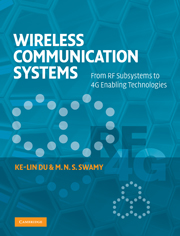Book contents
- Frontmatter
- Contents
- Preface
- Abbreviations
- 1 Introduction
- 2 An overview of wireless communications
- 3 Channel and propagation
- 4 Cellular and multiple-user systems
- 5 Diversity
- 6 Channel estimation and equalization
- 7 Modulation and detection
- 8 Spread spectrum communications
- 9 Orthogonal frequency division multiplexing
- 10 Antennas
- 11 RF and microwave subsystems
- 12 A/D and D/A conversions
- 13 Signals and signal processing
- 14 Fundamentals of information theory
- 15 Channel coding
- 16 Source coding I: speech and audio coding
- 17 Source coding II: image and video coding
- 18 Multiple antennas: smart antenna systems
- 19 Multiple antennas: MIMO systems
- 20 Ultra wideband communications
- 21 Cognitive radios
- 22 Wireless ad hoc and sensor networks
- Appendix A The Q-function
- Appendix B Wirtinger calculus
- Index
21 - Cognitive radios
Published online by Cambridge University Press: 05 June 2012
- Frontmatter
- Contents
- Preface
- Abbreviations
- 1 Introduction
- 2 An overview of wireless communications
- 3 Channel and propagation
- 4 Cellular and multiple-user systems
- 5 Diversity
- 6 Channel estimation and equalization
- 7 Modulation and detection
- 8 Spread spectrum communications
- 9 Orthogonal frequency division multiplexing
- 10 Antennas
- 11 RF and microwave subsystems
- 12 A/D and D/A conversions
- 13 Signals and signal processing
- 14 Fundamentals of information theory
- 15 Channel coding
- 16 Source coding I: speech and audio coding
- 17 Source coding II: image and video coding
- 18 Multiple antennas: smart antenna systems
- 19 Multiple antennas: MIMO systems
- 20 Ultra wideband communications
- 21 Cognitive radios
- 22 Wireless ad hoc and sensor networks
- Appendix A The Q-function
- Appendix B Wirtinger calculus
- Index
Summary
Conception of software-defined radio
Conception of software-defined radio (SDR) started in the early 1990s, and has now become a core technology for future-generation wireless communications. In 1997, the U.S. DoD recommended replacing its 200 families of radio systems with a single family of SDRs in the programmable modular communications system (PMCS) guideline document. An architecture outlined in this document includes a list of radio functions, hardware and software component categories, and design rules. The ultimate objective of SDR is to configure a radio platform like a freely programmable computer so that it can adapt to any typical air interface by using an appropriate programming interface. SDR is targeted to implement all kinds of air interfaces and signal processing functions using software in one device. It is the basis of the 3G and 4G wireless communications.
Proliferation of wireless standards has created the dramatic need for an MS architecture that supports multiband, multimode, and multistandard low-power radio communications and wireless networking. SDR has become the best solution. By using a unified hardware platform, the user needs only to download software of a radio and run it, and immediately shift to a new radio standard for a different environment. The download of the software can be over the air or via a smart card. For example, several wireless LAN standards, including IEEE 802.11, IEEE 802.15, Bluetooth, and HomeRF, use the 2.4 GHz ISM band, and they can be implemented in one SDR system.
- Type
- Chapter
- Information
- Wireless Communication SystemsFrom RF Subsystems to 4G Enabling Technologies, pp. 898 - 931Publisher: Cambridge University PressPrint publication year: 2010



